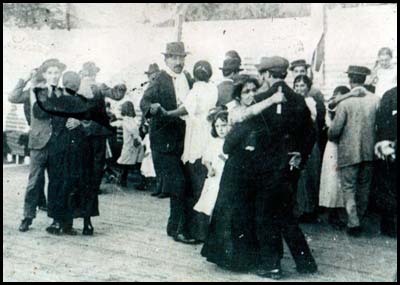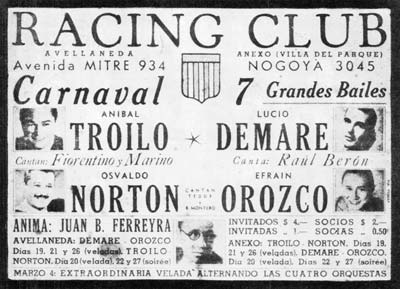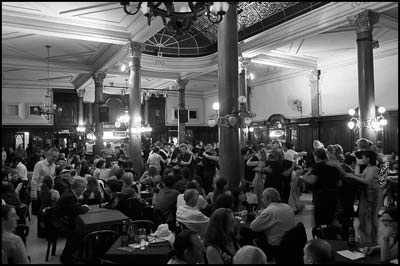By
Popular dance or, simply, the milonga

his is a thing connected with urban music and, some decades before, was an activity to which boys used to devote rather long time because they regarded dancing as a spiritual channel and for many of them it became a joyful rite, hardly replaceable.
In the twenties and also partly in the thirties, the venues where people used to go to dance were: backyard dances, neighborhood clubs —where dancing reunions were held—, dancing clubs, dancehalls, tearooms and night clubs. Many of these places lasted up to the late fifties.

The balls in the neighborhood clubs had features that were similar from one to the other. Music was mainly played by means of recordings. Some of them used to hire small music groups. Many of those groups later became widely aired or their members joined important orchestras. Likewise the great traditional clubs the timetable was: Saturday evenings from 10 pm to 4 am. In winter it was half an hour earlier. Sunday soirées in summer was from 8 pm to 12 pm and in winter, from 7 pm to 9 pm or a little bit later. It was customary that women were accompanied by their mothers or an older person. A great number of people became engaged because of dancing. Nearly always ladies did not pay an admission ticket.
Backyard dances were held at houses with a large courtyard and the attendants used to contribute with coins that were gathered to buy drinks. In winter the contributions consisted in doughnuts, small cakes or hot chocolate prepared by the hosts.
Further back in time, those backyards belonged to tenement houses that authors mentioned in their one-act farces (sainetes). At that time music was played in phonographs. In general, they used to be two because if there was only one it would become overheated and also its needles would be soon worn out.
The dancing couples that performed salon tango and outskirts-like tango used to go to dancing clubs. The features of the latter style are beat, elegance and figure. The salon style only has beat and elegance. Among many others and from different neighborhoods, clubs are (because they still exist): the Barracas Central, the Avenida Vélez Sarsfield 200; Huracán on Caseros Ave.; Unidos de Pompeya on Sáenz Ave.; the Sunderland of Villa Urquiza. The attendance were couples and also women and men alone. Music was mostly instrumental because people were only interested in dancing and did not care for vocalists as if they would prevent them from their concentration.
Dancing tearooms were in vogue in the forties and widely spread downtown in the Capital. We may mention: the Nobelon 800 Lavalle St.; the Lucerna and El Cairo on 500 Suipacha Street, one facing the other; Sans Souci on 900 Corrientes St.; Montecarlo on 1200 Corrientes St.; Picadilly on 1500 Corrientes Street.
All dancing tearooms used to hire one tango orchestra and a jazz band. For tango there were aggregations less known like Alberto Pugliese, Jorge Caldara, Roberto Caló, Enrique Alessio. The big names were associated with more important clubs. There was a matinée from 5 pm to 9:30 pm and the evening session was from 10 pm to 4 am. Gentlemen had to wear suits or sports coats but always with a necktie.

The classic announcers were Juan Zuchelli, Federico, Juan Macagno, Daniel Temple (son of the actor Eduardo Sandrini). Usually there was a central dance floor and around it was the bandstand and the tables were divided from the dancing track by a metal or wooden rail with four or five openings for the dancers.
When the tango orchestra was playing the lights were lower and when the jazz group was onstage the space was fully lit. Men used to invite girls to dance with a subtle nod from table to table. The orchestras played three or four numbers, sometimes more and then they had a rest. It was the first round then the jazz band entered. There were a second and third round.
These tearooms had «toilettes» for men and for women. Men may also have —if they paid for it— a hair salon service to shave, cut their nails, perfume and even nail varnishing.
Dancehall balls were held wherever there was a quite big central dance floor, at the back a stage for the musicians and chairs for the ladies around the dancing track. The buffet service was always outside the salon. Tango orchestras always had an appearance more than jazz bands. The orchestras that played at those venues were less known than the above. Vicente Sassano, the Típica Florida —led by Francisco Martante—, the Típica Polo —fronted by Raúl Apolo– and many others more.

Some of these salons were the Agusteo on 1300 Sarmiento Street; Príncipe George on 1200 Sarmiento St.; the 25 de Mayo on 3900 Venezuela St.; the Mariano Moreno on 1300 Santiago del Estero St.
And finally, a little below this rank: the summerhouses which had their walls covered by small crossed-over planks like those of old houses adorned with little plants and lights. Only for summer in the open air. There was the Munich on Costanera sur; La Colmena on Av. Forest and Céspedes; El parque colonial on Lavalle and Bouchard; El Palacio Rivadavia on 6097 Rivadavia Avenue.
I insist on these definitions. Salon tango is the tango danced within the music chords keeping the beat and elegance. It is the one called tango liso (straight tango). Masters of that style were Manuel Crespo and Juan César Mendieta. The outskirts tango (tango orillero) is the one that highlights beat, elegance and figure. Virulazo stood out either in the outskirts tango or the style for show. Tango canyengue derived from those. Its creator was José Méndez, who by exaggerating its movements included body rhythm. Another famous canyengue was Tarila (José Giambuzzi).
Despite they did not stir up the same interest, there were the milonga candombe (like those of Sebastián Piana and Homero Manzi) and the porteño waltz which derives from the criollo waltz and it is a danceable waltz like “Corazón de oro”, “Palomita blanca”, “Cortando camino” and many more with the same tango choreographies but in a waltz beat. It was important the way almost all young people were fond of dancing and, in many cases, they formed gangs that followed certain orchestras because each one has its own signature beat.